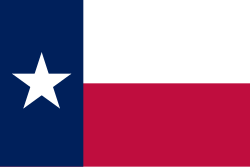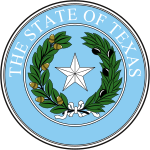Texas
Texas (/ˈtɛksəs/, also locally /ˈtɛksɪz/ American Spanish: [tejaz][8]), officially the State of Texas, is a state in the South Central Region of the United States. It is the second largest US state by total area (after Alaska) with 268,596 sq mi (695,662 km2) and population (after California) with nearly 29 million people as of 2019. Its largest cities are Houston, Dallas, Fort Worth, San Antonio, El Paso, and Austin, the capital city.
Texas | |
|---|---|
| State of Texas | |
| Nickname: The Lone Star State | |
| Motto: Friendship | |
| Anthem: "Texas, Our Texas" | |
 Map of the United States with Texas highlighted | |
| Country | United States |
| Before statehood | Republic of Texas |
| Admitted to the Union | December 29, 1845 (28th) |
| Capital | Austin |
| Largest city | Houston |
| Largest metro and urban areas | Dallas–Fort Worth |
| Government | |
| • Governor | Greg Abbott (R) |
| • Lieutenant Governor | Dan Patrick (R) |
| Legislature | Texas Legislature |
| • Upper house | Senate |
| • Lower house | House of Representatives |
| Judiciary | Supreme Court of Texas (Civil) Texas Court of Criminal Appeals (Criminal) |
| U.S. senators | John Cornyn (R) Ted Cruz (R) |
| U.S. House delegation | 23 Republicans 13 Democrats (list) |
| Area | |
| • Total | 268,596 sq mi (695,662 km2) |
| • Land | 261,232 sq mi (676,587 km2) |
| • Water | 7,365 sq mi (19,075 km2) 2.7% |
| • Rank | 2nd |
| Dimensions | |
| • Length | 801[1] mi (1,289 km) |
| • Width | 773[1] mi (1,244 km) |
| Elevation | 1,700 ft (520 m) |
| Highest elevation | 8,751 ft (2,667.4 m) |
| Lowest elevation | 0 ft (0 m) |
| Population (2022) | |
| • Total | 29,183,290[5] |
| • Rank | 2nd |
| • Density | 176/sq mi (67.9/km2) |
| • Rank | 26th |
| • Median household income | $64,034[6] |
| • Income rank | 23rd |
| Demonym(s) | Texan Texian (archaic) Tejano (usually only used for Hispanics) |
| Language | |
| • Official language | No official language (see Languages spoken in Texas) |
| • Spoken language | Predominantly English; Spanish is spoken by a sizable minority[7] |
| Time zones | |
| Majority of state | UTC−06:00 (Central) |
| • Summer (DST) | UTC−05:00 (CDT) |
| El Paso, Hudspeth, and northwestern Culberson counties | UTC−07:00 (Mountain) |
| • Summer (DST) | UTC−06:00 (MDT) |
| USPS abbreviation | TX |
| ISO 3166 code | US-TX |
| Traditional abbreviation | Tex. |
| Latitude | 25°50′ N to 36°30′ N |
| Longitude | 93°31′ W to 106°39′ W |
| Website | texas |
| Texas state symbols | |
|---|---|
 | |
 | |
| Living insignia | |
| Bird | Northern mockingbird (Mimus polyglottos) |
| Fish | Guadalupe bass (Micropterus treculii) |
| Flower | Bluebonnet (Lupinus spp., namely Texas bluebonnet, L. texensis) |
| Insect | Monarch butterfly (Danaus plexippus) |
| Mammal | Texas longhorn, nine-banded armadillo (Dasypus novemcinctus) |
| Reptile | Texas horned lizard (Phrynosoma cornutum) |
| Tree | Pecan (Carya illinoinensis) |
| Inanimate insignia | |
| Food | Chili |
| Instrument | Guitar |
| Shell | Lightning whelk (Busycon perversum pulleyi) |
| Ship | USS Texas |
| Slogan | The Friendly State |
| Soil | Houston Black |
| Sport | Rodeo |
| Other | Molecule: Buckyball (For more, see article) |
| State route marker | |
 | |
| State quarter | |
 Released in 2004 | |
| Lists of United States state symbols | |
Texas became the 28th state in the United States in 1845. Texas has been controlled by Spain, France, the Confederate States of America, and Mexico. It declared its independence from Mexico in 1836. It was its own country, the Republic of Texas, for 9 years (1836–1845). It is called the "Lone Star State" and its flag has one star.
There are many tourist attractions in Texas. Fort Worth is known for its stockyards. Amarillo is known for the cattle business and stockyards. In Dallas, industrial technology companies including Texas Instruments and EDS have their home offices. San Antonio has The Alamo. Houston has the Johnson Space Center. Austin has the University of Texas at Austin. Texas A&M University in College Station, Texas Tech University in Lubbock, Baylor University in Waco and the University of North Texas in Denton are other important universities in the state.
Name change
The state's name derives from táyshay, a word in the Caddoan language of the Hasinai (a Native American tribe), which means "allies" or "friends."
History change
Texas was first explored in 1528 by Spanish explorers on accident (they were shipwrecked on the coast). It did not become a colony until 1685, when France claimed it. In response, Spain started a rival colony in 1691 by setting up a religious outpost in the eastern part of Texas. Spain did not come back to Texas until 1716 to protect its colonies in the west from French forces. Two years later, San Antonio was founded.
The pressure between the Spaniards and Native Americans in East Texas stopped many settlers from coming to Texas. To stop the violence and the increasing Native American raids, Spain called a truce between many tribes in 1745 and 1789.
Tensions rose in Texas after the United States bought a large amount of nearby land from France in 1803. This was the Louisiana Purchase. People began wondering whether Spain or the United States could claim Texas.
Mexico won the Mexican War of Independence in 1821. Mexico, including Texas, was free from the Spanish Empire. Americans and other settlers came into Texas when Mexico allowed non-Spanish settlers to settle here. After many settlers came to Texas, Mexico started taxing non-citizens. This outraged many settlers. Many were already angry because Mexico banned slavery.
Politics in Mexico became violent and several Mexican States declared independence. On March 2, 1836, Texas declared independence from Mexico and soon they were at war. Texas won, but Mexico refused to recognize Texas as an independent sovereign Republic. Texas soon requested entry to the United States. Years later, in 1845, the US added Texas as a state,[9] and Mexico broke off diplomatic relations. Mexico resisted offers by the U.S. to buy land extending from Texas to the Pacific Ocean. In 1846, a dispute over the border between Texas and Mexico resulted in armed conflict, and the Mexican-American War began. The United States won the war, and by the Treaty of Guadalupe-Hidalgo, in 1848 won lands that later formed the states of California, Arizona, Nevada, Utah, New Mexico, southwestern Colorado, and southwestern Wyoming. Mexico received 15 million dollars and gave up its claims to Texas.
After Abraham Lincoln was elected President of the United States, Texas joined the newly formed Confederate States of America in 1861 and fought in the American Civil War in an attempt to become independent from the United States. The Confederates lost to the Union (the United States) in 1865. Texas was restored to full representation in Congress on March 30, 1870.
On January 10, 1901, oil was found in Texas, leading to the founding of a richer economy. During a time when the economy was poor, many people left Texas. Texas did not regain the population it had lost until the 1950s and 60s. In recent years, Texas has become a hub for technology and computers.
Geography change
Texas is the second biggest state in the Union (after Alaska) and is bigger than every European country except Russia. It has mountains, forests, deserts, plains, and coasts. The largest river in Texas is the Rio Grande, which forms the border between Mexico and the United States throughout south Texas. The highest mountain in Texas is Guadalupe Peak.
Most of Texas is in Central Time, but El Paso in Western Texas is in Mountain Time.[10]
Economy change
Texas has the second largest economy in the United States after the economy of California. It had a gross state product of US$1.887 trillion in 2019.[11] Texas was home to six of the top 50 companies on the Fortune 500 list in 2015 (third most after New York and California).[12] In 2017, Texas grossed more than US$264.5 billion a year in exports—more than the exports of California (US$172 billion) and New York (US$77.9 billion) combined.[13][14][15] As a sovereign country, in 2016, Texas would be the 10th largest economy in the world by gross domestic product (GDP), ahead of South Korea and Canada and behind Brazil.[16]
Related pages change
References change
- ↑ 1.0 1.1 Environment. Texas Almanac. 2008. Retrieved June 28, 2020.
- ↑ "El Capitan". NGS data sheet. U.S. National Geodetic Survey.
- ↑ 3.0 3.1 "Elevations and Distances in the United States". United States Geological Survey. 2001. Archived from the original on July 22, 2012. Retrieved October 24, 2011.
- ↑ Elevation adjusted to North American Vertical Datum of 1988.
- ↑ Bureau, US Census (April 26, 2021). "2020 Census Apportionment Results". The United States Census Bureau. Retrieved April 27, 2021.
- ↑ "Median Annual Household Income". The Henry J. Kaiser Family Foundation. 2019. Retrieved July 10, 2021.
- ↑ Texas—Languages. MLA. Archived from the original on May 22, 2011. Retrieved April 15, 2010.
- ↑ Wells, John C. (1982). Accents of English. Volume 3: Beyond the British Isles (pp. i–xx, 467–674). Cambridge University Press. p. 551. ISBN 0-52128541-0.
- ↑ "Resolutions" (PDF). Twenty-ninth Congress. 1845. Archived from the original (PDF) on May 25, 2017. Retrieved May 16, 2017.
- ↑ "Mountain Time Zone Boundary". www.timetemperature.com. Retrieved April 13, 2018.
- ↑ "Gross domestic product (GDP) by state (millions of current dollars)". Bureau of Economic Analysis. Retrieved June 29, 2017.
- ↑ "FORTUNE 500 2011: States". CNN.
- ↑ "State Exports for TEXAS". United States Census Bureau. Retrieved October 29, 2013.
- ↑ "State Exports for CALIFORNIA". United States Census Bureau. Retrieved October 29, 2013.
- ↑ "State Exports for NEW YORK". United States Census Bureau. Retrieved October 29, 2013.
- ↑ "In Opinion: If states were countries by economic output, California would be France". Newsweek. June 11, 2016. Retrieved June 30, 2017.

